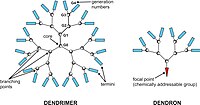
Photo from wikipedia
A visual drug delivery system (DDS) is urgently needed for precision medicine. DDS-mediated bioorthogonal prodrug activation strategies have demonstrated remarkable advantages in enlarging a therapeutic index via the alleviation of… Click to show full abstract
A visual drug delivery system (DDS) is urgently needed for precision medicine. DDS-mediated bioorthogonal prodrug activation strategies have demonstrated remarkable advantages in enlarging a therapeutic index via the alleviation of adverse drug reactions. However, the events of bioorthogonal prodrug activation remain inaccessible. Here, we construct a self-reporting bioorthogonal prodrug activation system using fluorescence emission to interpret prodrug activation events. In designed reactive oxygen species (ROS)-instructed supramolecular assemblies, the bioorthogonal reaction handle of tetrazine carries a dual role as fluorescence quencher and prodrug activator. The subsequent inverse-electron-demand Diels-Alder (IEDDA) reaction simultaneously liberates fluorescence and active drugs, which form a linear relationship. Differentiated by their cellular redox status, ROS-instructed supramolecular assemblies form selectively in both tumor cells and cell spheroids. Upon prodrug treatment, the brightness of fluorescence reflects the liberation of active drugs, which further correlates with the cell survival rate. Therefore, a fluorescence-based visualizable DDS (VDDS) for bioorthogonal prodrug activation is demonstrated, which should be useful to elucidate the multi-step processes in drug delivery and determine prodrug activation efficacy.
Journal Title: Biomaterials science
Year Published: 2022
Link to full text (if available)
Share on Social Media: Sign Up to like & get
recommendations!